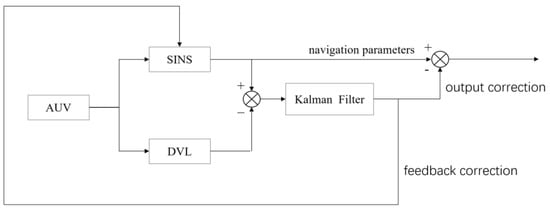Abstract
Underwater vehicles are key carriers for underwater inspection and operation tasks, and the successful implementation of these tasks depends on the positioning and navigation equipment with corresponding accuracy. In practice, multiple positioning and navigation devices are often combined to integrate the advantages of each equipment. Currently, the most common method for integrated navigation is combination of the Strapdown Inertial Navigation System (SINS) and Doppler Velocity Log (DVL). Various errors will occur when SINS and DVL are combined together, such as installation declination. In addition, DVL itself also has errors in the measurement of speed. These errors will affect the final accuracy of the combined positioning and navigation system. Therefore, error correction technology has great significance for underwater inspection and operation tasks. This paper takes the SINS/DVL integrated positioning and navigation system as the research object and deeply studies the DVL error correction technology in the integrated system.
1. Introduction
Underwater vehicle is a key carrier for underwater exploration, playing a very important role in marine environment perception, navigation target recognition, seabed geological exploration, and underwater rescue, among others. Underwater vehicles have experienced various development stages, from manned underwater vehicles (MUV) to unmanned underwater vehicles (UUV), where autonomous unmanned vehicles (AUV) are the main research direction of future underwater vehicles [1,2]. AUV can rely on autonomous navigation to conduct its underwater navigation, and it also has the characteristics of low noise, high concealability, miniaturization, and high intelligence, so it has wide application prospects in both military and civilian fields [3]. The performance of underwater vehicle navigation system has been put forward higher requirements with the ocean exploration technology’s rapid development and demand’s expansion. The Strapdown Inertial Navigation System (SINS) is an autonomous navigation calculation system, and it can provide relatively accurate positioning and navigation information based on its initial navigation information when it is little affected by external signals. The inertial components (gyroscope and accelerometer) in SINS can obtain the real-time navigation parameters of the underwater carrier through strapdown solution [4]. However, the time integral operation in the navigation calculation process makes the errors of the inertial measurement components accumulate continuously, and the navigation performance of the system gradually decreases. Similarly, any single sensor has limitations of its working conditionality, so the task of measuring the navigation information of the underwater vehicle needs to be completed by the combination of multiple navigation devices [5,6]. The technology of integrated processing of two or more navigation sensor measurements is integrated positioning and navigation technology, which can make the navigation results more reliable. SINS/DVL integrated positioning and navigation system is the main combined system used in underwater integrated positioning and navigation at present. DVL provides real-time velocity measurement information as an external auxiliary velocity measuring instrument, combines with the parameters of SINS, inhibits the accumulation of SINS’s time integration errors, and improves the performance of navigation equipment [7,8]. The SINS/DVL integrated positioning and navigation system, with a high degree of autonomy, high positioning accuracy, and strong stability, will play a more important role in the development of underwater vehicle navigation technology in the future [9].
The accuracy of the navigation system is the key factor of the underwater vehicle’s effective operation, and thus, improving the accuracy is the most important goal of the design of the navigation system. The errors of SINS/DVL integrated positioning and navigation system mainly include inertial device errors, sensor installation errors, alignment errors, and DVL velocity measurement errors, among which the DVL velocity measurement errors include formula simplification errors, sound velocity errors, carrier attitude variation errors, beam broadening errors, and so on [10].
In the DVL/SINS integrated positioning and navigation system, the state equation of Kalman filtering is composed of SINS error equations. According to the different expressions of attitude errors, the main SINS error equation are Euler angle error models and quaternion error models [11,12]. Regarding the problem of precision in traditional SINS error models, Andrle M.S. proposed an error construction idea based on vector operation coordinate system consistency. On this basis, Wang M. pointed out that the traditional definition of SINS velocity error only considers the difference between the actual velocity and the theoretical velocity, ignoring the impact of inconsistent vector coordinate systems [13]. Changl B. and Zhao R.J. defined velocity error in the computational navigation system, derived the Euler angle and quaternion forms of the GNSS damped SINS nonlinear error model, and applied them to GNSS/SINS large misalignment angle alignment [14,15]. To the instability of the DVL signal, Zhao Jun-bo and Song Jin-xue proposed using other methods to replace the DVL signal in order to get more accurate position [16].
In this paper, mainly focused on DVL error correction to improve the accuracy of DVL/SINS integrated positioning and navigation system, a feasible integrated positioning and navigation system is designed by studying SINS/DVL integrated positioning and navigation filtering algorithm. For the factors which affect the speed measurement accuracy of DVL, we establish the DVL error model, compensating the error of the algorithm comprehensively: (a) A sound speed measuring instrument is used to obtain the sound speed information of the carrier, compensating for the sound speed error in real time. After correction, the speed measurement data of DVL are closer to the carrier’s setting speed. (b) The correction method of the carrier attitude error is studied, and by using the change data of the carrier roll angle, pitch angle, and heading angle obtained by the attitude sensor, DVL is compensated for the attitude error. The corrected carrier’s navigation trajectory is closer to the real trajectory. (c) A covariance-based outlier detection and removal method for the mutation outliers in DVL data are studied. Through simulation analysis, this method can effectively remove DVL mutation data and ensure the validity of the data. Finally, a simulation of the system is carried out and experiments are performed [17]. The research of DVL velocity error correction technology in the integrated positioning and navigation system is an important key aspect to improve the overall accuracy of the integrated positioning and navigation system, which has high engineering practice value [18].
3. DVL Error Correction Method
Integrated positioning and navigation technology is an effective means to improve the performance of underwater vehicle navigation equipment. DVL as a key sensor in underwater acoustic navigation, and is often used in integrated positioning and navigation system, playing an important role in underwater navigation. DVL can measure the high accuracy velocity parameters of the carrier to the bottom, which can be used to suppress the time divergence problem of SINS navigation parameters in SINS/DVL integrated positioning and navigation system. The SINS/DVL integrated positioning and navigation system has errors when the two sensors are combined working, including SINS and DVL installation errors. Additionally, DVL itself has speed measurement errors.
DVL will generate errors when operating in SINS/DVL integrated positioning and navigation system. According to the error source, the speed measurement errors of DVL can be divided into the following four categories: (1). Errors related to the working principle and structure of DVL, such as the formula simplification error, sound velocity error, beam broadening error, etc. (2). Errors generated in SINS/DVL integrated positioning and navigation system, such as the installation deviation error and rod arm error. (3). Errors caused by the unstable motion state of the carrier carrying navigation equipment, such as the attitude error of the carrier. (4). Errors caused by complex external environment when DVL works underwater, such as the outlier or short-term invalidity of DVL velocity data.
The key to improve the accuracy of integrated positioning and navigation system is to calibrate and correct DVL velocity measurement errors. In this chapter, the error analysis and correction of DVL in the integrated positioning and navigation system are studied. Through the selection of DVL parameters, the DVL error calibration technology is studied. Moreover, we analyze the error sources of the DVL velocity measurement errors, and correct the errors caused by the sound speed, installation deviation angle, and carrier attitude. Simulations or experimental analyses are conducted to verify the effectiveness of the correction methods in improving navigation accuracy. At the same time, we propose methods for short-time invalid data, such as outliers during DVL operation. Finally, the comprehensive DVL correction method is tested on a lake to verify the feasibility of the correction method.
3.1. Sound Velocity Error Correction
The variation of sound velocity has spatial and temporal characteristics, and there is an obvious difference in sound velocity in different waters and different seasons. According to the Oceanic Station Observation Data provided by the State Oceanic Administration, the variation of sound velocity in water is near 7% in the temperature range from −16.4 °C in the polar region to 15.8 °C in the equator region. The average salinity variation from the Yangtze River to Dalian port is in the range of 6.5‰~30.3‰, and the variation of sound velocity in water affected by salinity is more than 1%. Considering the actual use of AUV in different seasons and waters, the DVL velocity measurement errors caused by sound velocity errors should not be ignored.
The relative error between the measured speed and the accurate speed of DVL caused by sound velocity can be deduced as follows:
where is the design sound speed of DVL transmitting sound wave, usually 1504 m/s.
The actual sound velocity on the sea surface varies from 1450 m/s to 1550 m/s. Table 1 shows the relative error of DVL velocity measurement due to the change of sound velocity. It can be seen that the error of sound velocity can cause the DVL velocity measurement to reach a percentage, so it is necessary to correct the error of the sound velocity.

Table 1.
Influence of the sound velocity variation on the DVL velocity measurement.
The common sound velocity correction methods are as follows: adjusting the inclination angle of the transducer to make the ratio of the beam angle cosine value to the designed sound velocity constant, and automatically compensate the sound velocity error; using the phased-array DVL to compensate the inclination and phase of multiple array elements. In this paper, the sound velocity compensation method is adopted, assisted by the sound velocity measurement instrument, to obtain the actual sound velocity in the operating water area, and the real-time sound velocity error calibration and compensation is carried out to correct the DVL velocity measurement error.
3.2. Carrier Attitude Error Correction
DVL speed measurement results will be inaccurate due to the change of the carrier attitude. Therefore, the carrier should reduce turbulence and shaking and be as stable as possible during navigation. However, due to the influence of external environmental factors, the attitude change of the carrier is inevitable, and the attitude error must be corrected and compensated for. In this paper, using the attitude sensor to obtain the attitude angle change of the carrier during operation, compensate for the measured speed value, and correct the DVL measured speed in real time.
The working frequency of the transducer of DVL reaches hundreds to thousands kHz, the transmitting interval of the adjacent beams is very short, and the propagation velocity of the sound wave in water changes rapidly compared with the attitude angle of the carrier. During the roundtrip time from the sound wave transmitting to the receiving time, it is approximately assumed that the carrier has no attitude change.
For the DVL configured with four-beam Janus, the transducer transmits acoustic beams from the bottom of the carrier to the seabed with the same beam inclination along the four axis directions. Assuming that the DVL beam inclination is 60°, the angle between the transmitting beam and the negative half axis of the axis is 30°. The coordinate diagram of DVL velocity measurement with four-beam Janus is shown in Figure 3. The velocity component of the carrier in the three directions is , and the velocity of the carrier measured by the four beams is . We set the landing points of beams 1 and 3 to be distributed on the X-axis, and the landing points of beams 2 and 4 to be distributed on the Y-axis. The pitch attitude compensation angle is; the roll attitude compensation angle is , the roll angle is positive when the carrier is tilted to the right, and the roll angle is positive when the carrier is raised at the bow. The carrier velocity measured by each beam is as follows:
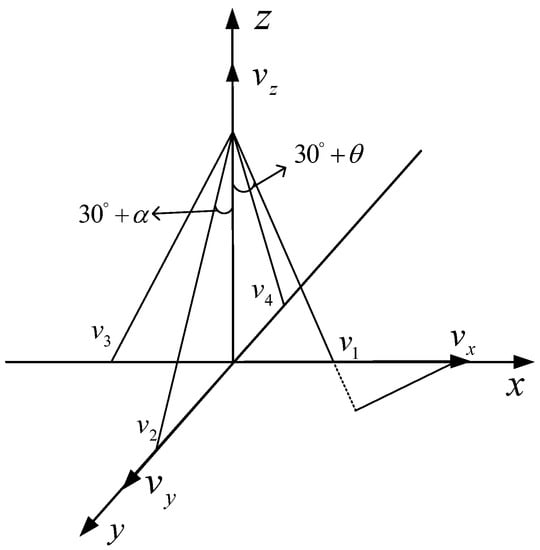
Figure 3.
Schematic diagram of the DVL velocity measurement coordinates configured by four-beam Janus.
According to the above formula, considering the influence of carrier attitude error, the formula for calculating carrier attitude compensation velocity in transverse, longitudinal, and vertical directions is as follows:
3.3. Detection and Rejection of DVL Velocity Outliers
3.3.1. Source of Outliers
Under the bottom-to-bottom operation mode of DVL, as shown in Figure 4, the velocity measurement results show outliers in the following situations: (a) Sound waves emitted by the DVL transmitter transducer are blocked by Marine organisms and cannot reach the bottom. (b)When AUV encounters deep trenches on the bottom, the propagation time of sound waves suddenly becomes longer or the working water depth exceeds the measurement range. (c) The underwater strong wave absorbing medium completely absorbs the sound energy, and the receiver cannot receive the reflected signal. (d) When the attitude of AUV changes drastically (such as a large angle pitch) or specular reflection occurs in uncertain direction, part of the reflected signal cannot return to the transducer.
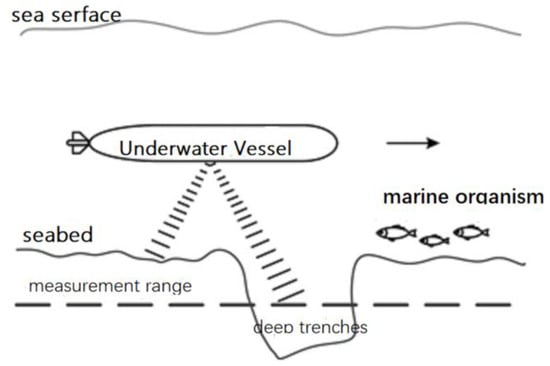
Figure 4.
Failure of the DVL velocity measurement.
If the DVL measurement data fail for a short time, the abnormal velocity measurement results are introduced into the integrated navigation system to assist SINS positioning and navigation, which will lead to the abnormal navigation data of the integrated navigation system at some time, and will accumulate with the iteration process, which will seriously affect the positioning and navigation accuracy and AUV navigation. Therefore, invalid outliers must be processed before combined filtering of navigation data.
3.3.2. Detection and Rejection of DVL Outliers Based on Covariance
In the combined system, the difference between the measured value of Kalman filter and the measured value of DVL is called Innovation, which represents the error of measurement estimation.
The discrete filtering model of SINS/DVL combined system is as follows:
Further state prediction:
State prediction mean-square error matrix:
Filtering gain:
State estimation:
State estimation mean-square error matrix:
The real-time variation of DVL measured speed is reflected by innovation, and its formula is as follows:
The variance of the Innovation is:
where is the predicted value of Kalman filter variance matrix at time k, , and is Kalman Gain.
If the value of Innovation changes greatly at a certain instant, the Innovation at that moment is positioned as:
When the value of the Innovation suddenly changes, , the DVL velocity measurement value at that moment should be isolated, that is, outliers should be eliminated to prevent outliers from being introduced into the combined system for data fusion with SINS and to prevent affecting the navigation and positioning of the system.
4. Experimental Analysis
4.1. Experimental Analysis of Sound Velocity Error Correction
In the actual water area with water temperature of 8 °C and salinity of 35‰, the sailing speed of AUV was set as 1.3 m/s and the sailing time was 5000 s. The actual sound speed was measured by the sound speed measuring instrument in real time, and the actual sound speed was replaced by the designed sound speed of DVL to calculate the DVL speed. Figure 5 shows the comparison of DVL speed measurement results before and after the sound speed correction. Figure 6 shows the measured velocity curve.
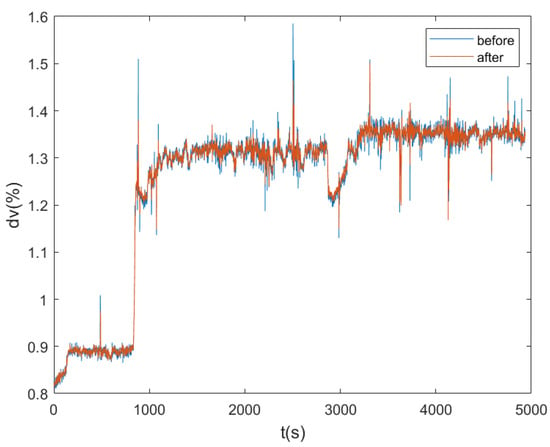
Figure 5.
Comparison of DVL velocity measurement results before and after sound velocity correction.

Figure 6.
Relative error curve of DVL velocity measurement under the influence of sound velocity.
The experimental results show that under the same time, space, and navigation depth, the sound velocity curve measured by the sound velocity measurement instrument is stable. However, there are errors between the actual sound velocity and the designed sound velocity (1504 m/s), and the magnitude of the sound velocity error is different under different working environments. The speed of AUV measured by DVL is obviously different before and after the error correction of sound speed. It can be seen from Figure 6 that the relative error of DVL velocity measurement can reach 1.173%, only under the influence of the sound velocity error when other conditions are unchanged, and the carrier velocity closer to the real value can be obtained after sound velocity correction. The sound velocity compensation method assisted by sound velocity measurement instrument is an economical and effective sound velocity correction method.
4.2. Experimental Analysis of Carrier Attitude Error Correction
In this section, the carrier attitude correction method is experimentally verified and analyzed. In order to visually and explicitly verify the effect of attitude error correction, it is assumed that the installation error angle and calibration factor error have been calibrated in the experiment. Experimental settings: AUV was set to sail in a straight line at a speed of 2 m/s with a sailing time of 1200 s. The initial course deviation Angle of the AUV was 0.1°, and the initial roll and pitch deviation angles were zero.
The DVL velocity error curves before and after attitude correction are shown in Figure 7. The experimental results show that the forward velocity of DVL oscillates in the range of plus or minus 0.1 m/s before attitude correction. After attitude correction, the forward velocity measurement error of DVL is significantly reduced, and the error remains around zero. Before and after the correction, the DVL velocity error in the right direction is small. After the correction, the velocity error curve in the right direction is smoother and the velocity error value is reduced to a certain extent.
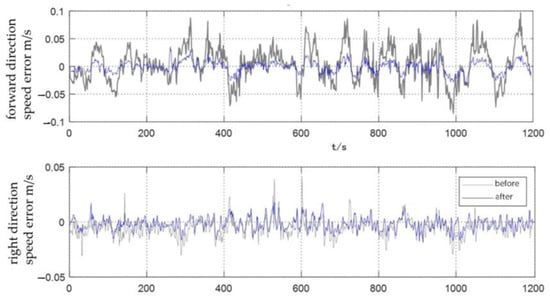
Figure 7.
Comparison of DVL velocity measurement before and after carrier attitude error correction.
The experimental results of position error correction for SINS/DVL integrated navigation positioning with DVL velocity after attitude error correction are shown in Figure 8. It can be seen that, without considering the DVL speed measurement error, when the speed measured by log and SINS navigation data are fused and solved directly, the east and north position errors are more than 100 m, when the DVL speed compensated for attitude error is fused with SINS navigation data for integrated navigation, the position errors in both directions are less than 10 m. The carrier attitude error correction method has a good effect on improving the positioning and navigation accuracy of the integrated system.
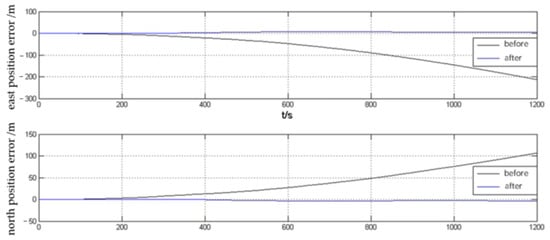
Figure 8.
Positioning errors of the combined system before and after attitude correction.
4.3. Experimental Analysis of DVL Outlier Rejection Method
In order to verify the DVL outlier detection and rejection method based on covariance, the method of experiment and simulation is adopted. On the basis of DVL experimental data, the regularity of DVL velocity outlier is simulated by simulation. The combined system adopts the same initial index as in Section 3.2, and stipulates that the vehicle moves in a uniform straight line at the speed of 3 m/s in the direction of 30° north by east, with a running time of 3600 s.
The DVL velodrome values were set as follows: at an interval of 300 s, the velocity outliers were added to the DVL right-direction velocity, and the amplitude of the velocity outliers was increased by 0.1 m/s each time from 0.1 m/s; at an interval of 400 s, the velocity outliers were added to the DVL forward velocity, and the amplitude of the velocity outliers was increased by 0.15 m/s each time from 0.1 m/s. The DVL velocity data with outliers were estimated by Kalman filtering, and the modulus of Innovation is shown in Figure 9.
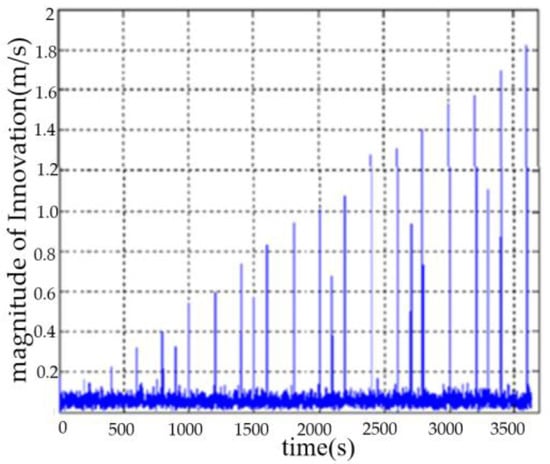
Figure 9.
The modulus of Innovation with outliers of DVL velocity.
The DVL velocity data were modified by the outlier elimination method based on covariance, and Figure 10 shows the modulus of the revised Innovation. It can be seen that this method can effectively detect and eliminate outliers in DVL velocity data. After eliminating outliers, the measured values of DVL velocity and the estimated values of filter velocity are stable at about 0.09 m/s.
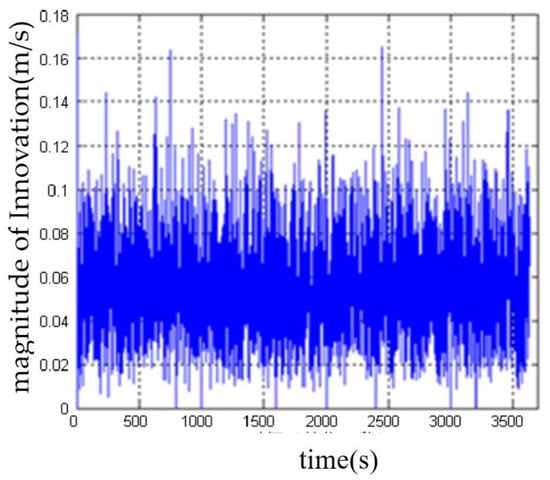
Figure 10.
The modulus of Innovation after eliminating the outliers of DVL velocity data.
By comparing the simulation results, it can be seen that the outlier rejection method based on covariance idea can effectively detect and eliminate the outlier of DVL velocity, avoid the introduction of jump information into the measurement equation of the combined system, reduce the positioning and navigation error of the combined system to a certain extent, and improve the stability of the combined system.
4.4. Experimental Analysis of the Global Correction of DVL Velocity Measurement Errors
4.4.1. Experimental Scheme and Equipment
In the previous chapter, the error sources of DVL velocity measurement are analyzed in detail, while at the same time, the sound velocity error, installation deviation angle and calibration factor error, and carrier attitude error and DVL velocity measurement outliers are studied. In order to verify the overall feasibility of the combined application of each correction method, the lake test analysis of the overall DVL error correction method is carried out in this section.
The Sprite E200D small AUV was used as the test platform, as shown in Figure 11. The main navigation sensors in SINS/DVL integrated positioning and navigation system are optical fiber SINS and DVL configured with four-beam Janus. In addition, the AUV platform is equipped with DGPS, sound speed measurement instrument, attitude measurement instrument, depth meter, and other auxiliary measurement modules. The overall DVL correction block diagram of SINS/DVL integrated positioning and navigation system is shown in Figure 12.
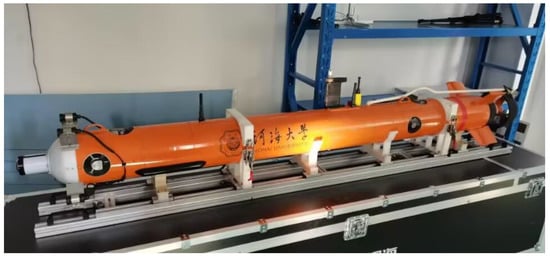
Figure 11.
Sprite E200D small AUV.
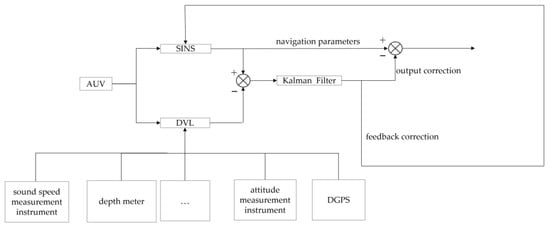
Figure 12.
Overall DVL correction block diagram of the combined system.
The AUV runs in a straight line at a speed of 1.5 m/s with a sailing time of 3600 s. The AUV was designed to run on the surface in order to get DGPS’s outputting information. The DVL speed measurement error is corrected in real time using the measured data of each module. The modified DVL speed is involved in the navigation calculation of the combined system, and the navigation information output by DGPS is used as the reference. The main performance indexes of the experimental equipment are shown in Table 2.

Table 2.
Main performance indicators of the experimental equipment.
4.4.2. Analysis of Experimental Results
After the DVL speed measurement error is compensated by various correction methods, it is input into the integrated positioning and navigation system for data fusion, and the AUV running trajectory is obtained. The trajectory is compared with the uncorrected solved trajectory and the real benchmark trajectory obtained by differential GPS, as shown in Figure 13.
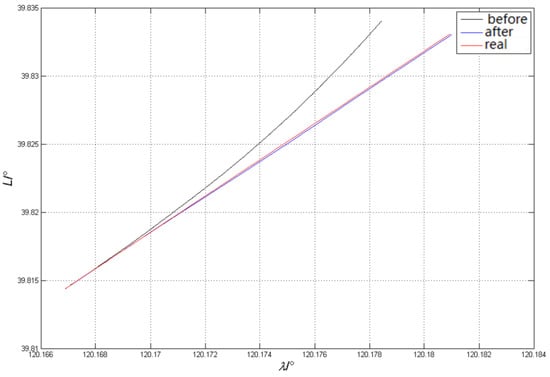
Figure 13.
Comparison of AUV trajectories before and after DVL error correction.
Table 3 shows the statistical results of the navigation position errors, where the relative error is the ratio of the maximum position error and the range.

Table 3.
Comparison of the results before and after DVL correction.
It can be seen from the experimental results that the settlement result error of SINS/DVL integrated positioning and navigation system before correction will increase with the increase of voyage time, and the running track under long voyage will deviate from the set course. After correcting the overall errors of DVL sound speed, installation deviation angle and scale factor, and carrier attitude and speed measurement outliers, the corrected navigation results are closer to the real trajectory of AUV, and the relative position error is greatly reduced.
The experimental results show that the proposed DVL global correction method can effectively correct the DVL velocity error and improve the accuracy of SINS/DVL integrated positioning and navigation system.
5. Conclusions
This paper takes the SINS/DVL integrated positioning and navigation system as the starting point, analyzes the error sources of DVL in the system in detail, focuses on the DVL error correction methods, and analyzes the improvement effect of each correction method on DVL speed measurement accuracy and SINS/DVL integrated positioning and navigation accuracy through simulation and experimentation.
The main work content of this paper is as follows:
- Combined with the working principle of SINS and DVL, deducing the basic equations and establishing their respective error models. On this basis, we design the SINS/DVL integrated positioning and navigation system.
- Studying the DVL error correction method of the integrated positioning and navigation system. Firstly, we analyze the source of DVL speed measurement error, and then we study the correction and compensation methods for each error factor: (a) Using the sound speed measuring instrument to obtain the sound speed information of the carrier, and compensating the sound speed error in real time. After correction, the speed measurement data of DVL is closer to the carrier’s setting speed. (b) Studying the correction method of the carrier attitude error, using the change data of carrier roll angle, pitch angle, and heading angle obtained by the attitude sensor, DVL is compensated for the attitude error. The corrected carrier’s navigation trajectory is closer to the real trajectory. (c) Studying a covariance-based outlier detection and removal method for the mutation outliers in DVL data. Through simulation analysis, this method can effectively remove DVL mutation data and ensure the validity of the data.
- Applying the above-mentioned DVL error correction method for overall correction, using AUV to carry out the lake test, the lake test results verify the effectiveness of the overall DVL error correction method.
For SINS/DVL integrated navigation and positioning technology, especially in DVL combination system error correction technology research, can effectively compensate for the combined system of all kinds of system errors and random error influence on the precision of vehicle navigation, improve the precision and stability of the navigation and positioning, help the development of underwater vehicles, and have a certain practical value in engineering practice.
In this paper, the DVL error correction method of SINS/DVL integrated positioning and navigation system is studied in depth, but there are still some problems to be further studied and solved, including: (a) In the design of the integrated navigation system, the initial alignment technology is not studied in depth, and the correlation between the DVL speed measurement error correction method and the initial alignment of the system can be explored later. (b) In this paper, the combination scheme of standard Kalman filtering and loose coupling is adopted. In the next step, nonlinear filtering algorithms, such as unscented Kalman filtering, can be used to design the integrated navigation system in tight coupling mode to explore the applicability of the DVL error correction method in different combination modes. (c) Some parameters are simplified in the system modeling, and the interference of external factors, such as underwater currents and organisms, is ignored in the DVL error analysis. These error sources need to be further studied and processed.
Author Contributions
J.L. initiated the idea; M.G. contributed to the experiment; T.Z., Z.W., Z.Z. and G.H. contributed to the statical analysis of data. All authors have read and agreed to the published version of the manuscript.
Funding
This work is supported by the National key R&D Program [2022YFB4703403], the NSF of China (Grant No.12274113), and in part by the Research Fund from Science and Technology on Underwater Vehicle Technology Laboratory (No.6142215200102).
Institutional Review Board Statement
Not applicable.
Informed Consent Statement
Not applicable.
Data Availability Statement
The data that support this study are available from the corresponding author, upon reasonable request.
Conflicts of Interest
The authors declare no conflict of interest.
References
- Han, G.; Long, X.; Zhu, C.; Guizani, M.; Zhang, W. A High-Availability Data Collection Scheme based on Multi-AUVs for Underwater Sensor Networks. IEEE Trans. Mob. Comput. 2019, 19, 1010–1022. [Google Scholar] [CrossRef]
- Jin, K.; Chai, H.; Su, C. Current status and trend of DVL/SINS integrated navigation technology. J. Navig. Locat. 2022, 1–15. [Google Scholar]
- Wang, B.; Liu, J.; Liu, P. Review of SINS/DVL integrated navigation technology. J. Navig. Locat. 2020, 8, 1–6. [Google Scholar]
- Zhang, T.W.; Tang, J.L.; Qin, S.J.; Wang, X. Review of navigation andpositioningofdeep-sea manned submersibles. J. Navig. 2019, 72, 1021–1034. [Google Scholar] [CrossRef]
- Zhao, J.; Ge, X.; Feng, X.; Zhou, H.-K. A review of underwater SINS/DVL integrated navigation technology. J. Unmanned Undersea Syst. 2018, 26, 2–9. [Google Scholar]
- Han, G.; Tang, Z.; He, Y.; Jiang, J.; Ansere, J.A. District Partition-based Data Collection Algorithm with Event Dynamic Competition in Underwater Acoustic Sensor Networks. IEEE Trans. Ind. Inform. 2019, 15, 5755–5764. [Google Scholar] [CrossRef]
- Liu, X.; Wang, L.; Wang, L.; Huang, Y.; Wang, Z. SINS/DVL Integrated System with Current and Misalignment Estimation for Midwater Navigation. IEEE Access 2021, 9, 51332–51342. [Google Scholar] [CrossRef]
- Jang, J.; Student, K.G.; Cho, H.; Kim, J.; Byun, S.-W. Geophysical Navigation for UUV without External Telemetry Systems. J. Korea Robot. Soc. 2020, 15, 24–31. [Google Scholar] [CrossRef]
- Lu, D.; Song, S.; Wang, J.; Cai, Y.; Shen, H. Review on the development of SINS/DVL underwater integrated navigation Technology. Control Theory Appl. 2022, 39, 1159–1170. [Google Scholar]
- Leonard, J.; Bahr, A. Autonomous Underwater Vehicle Navigation. In Handbook of Ocean Engineering; Springer: Berlin/Heidelberg, Germany, 2016. [Google Scholar]
- Andrle, M.S.; Crassidisj, L. Attitude estimation employing common frame error representations. J. Guid. Control Dyn. 2015, 38, 1614–1624. [Google Scholar] [CrossRef]
- Zhu, T.G.; Liu, Y.; Li, W.K.; Li, K. The quaternion-based attitude error for thenonlinear error model of the INS. IEEE Sens. J. 2021, 21, 25782–25795. [Google Scholar] [CrossRef]
- Wang, M.s; Wu, W.Q.; Zhou, P.Y.; He, X. State transformation extended Kalman filter for GPS/SINS tightly coupled integration. GPS Solut. 2018, 22, 112. [Google Scholar] [CrossRef]
- Chang, l.B.; Qin, F.J.; Jiang, S. Strap down inertial navigation system initial alignment based on modified process model. IEEE Sens. J. 2019, 19, 6381–6391. [Google Scholar] [CrossRef]
- Zhao, R.J.; Lik, L.; Hu, B.Q.; Tian, J. SINS initial alignment algorithm based on improved quaternion damping error model. Syst. Electron. 2021, 43, 3330–3337. [Google Scholar]
- Song, J.-X. Model-Aided and Sea Current Estimation for UUV Autonomous Navigation Research; Harbin Engineering University: Harbin, China, 2018. [Google Scholar]
- Liu, J.; Li, H.; Ma, S.; Luo, J. AUV DVL integrated navigation system of error calibration technology overview. In Proceedings of the Inertial Technology Development Direction Symposium on Cuttingedge Technology and the Integration and Application of Inertial Technology, Virtual, 22–25 March 2021; pp. 138–143. [Google Scholar]
- Guo, Y.; Fu, M.; Deng, z.; Deng, Z.-H. SINS/DVL integrated navigation algorithm considering the impact of ocean currents. J. Chin. Inert. Technol. 2017, 25, 738–742. [Google Scholar]
- Liu, P. Research on Key Technologies of INS/DVL Integrated Navigation; Beijing Institute of Technology: Beijing, China, 2018. [Google Scholar]
- Huang, X.; Wang, Y. Kalman Filter Principle and Application; Publishing House of Electronics Industry: Beijing, China, 2015. [Google Scholar]
- Zhang, J. Research on Underwater INS/USBL-INS/DVL Integrated Navigation Method under Non-Ideal Conditions; Harbin Engineering University: Harbin, China, 2019. [Google Scholar]
- Kalman, R.E. A New Approach to Linear Filtering and Prediction Problems. J. Basic Eng. 1960, 82D, 35–45. [Google Scholar] [CrossRef]
- Tong, Z. Current status analysis of foreign underwater navigation technology. Ship Electron. Eng. 2016, 36, 8–10. [Google Scholar]
- Paull, L.; Saeedi, S.; Seto, M.; Li, H. AUV Navigation and Localization: A Review. IEEE J. Ocean. Eng. 2014, 39, 131–149. [Google Scholar] [CrossRef]
Disclaimer/Publisher’s Note: The statements, opinions and data contained in all publications are solely those of the individual author(s) and contributor(s) and not of MDPI and/or the editor(s). MDPI and/or the editor(s) disclaim responsibility for any injury to people or property resulting from any ideas, methods, instructions or products referred to in the content. |
© 2023 by the authors. Licensee MDPI, Basel, Switzerland. This article is an open access article distributed under the terms and conditions of the Creative Commons Attribution (CC BY) license (https://creativecommons.org/licenses/by/4.0/).

